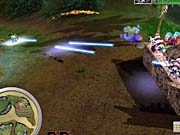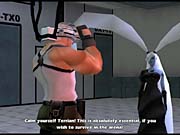The real-time strategy genre has become incredibly competitive recently, thanks to exceptional games like Command & Conquer: Generals, Age of Mythology, and Warcraft III. However, The Gladiators: Galactic Circus Games distinguishes itself with extremely fast-paced gameplay and an offbeat story. Unfortunately, technical problems and frustrating difficulty levels mar an otherwise solid game.

The story follows the misadventures of military hero Major Greg Callahan. After the Vietnam war, Callahan becomes an astronaut and gets launched into a black hole. After entering the mysterious vortex, he ends up trapped on an alien planet where the primary form of entertainment is gladiator combat. The gladiators serve as field generals and lead troops into battle for the entertainment of stadium spectators. In this arena, he's forced to fight the reigning champion, General Maximix and his galactic robot army, as well as a demon named Fargass and his hordes of monsters. Helping Callahan is the alien princess Lydia, who signs Callahan on as her champion in the competition.
The Gladiators' comic-book-style graphics are colorful and vibrant. On the battlefield, the units are smoothly animated and the weapon effects are violently over the top--dead units spill a great deal of blood, and mechanical units break up in spectacular explosions. You can rotate the screen to any angle, and zoom in to get a closer look, although you'll spend the vast majority of your time zoomed out to see as much of the field as possible.
The Gladiators' graphics falter during the cutscenes, because the game's 3D engine looks good at a distance, but up close, the 3D models aren't detailed enough to be very attractive. However, the game's sound makes up for this shortcoming, since the campy story is delivered with comical, B-movie-style voice acting. The fact that the character models' mouths don't move during the dialogue adds even more camp to the atmosphere. Fortunately, The Gladiators never really takes itself too seriously, so these issues aren't much of a problem. The game's sound effects are also decent--the sounds of battle are satisfying enough, and the stadium crowd will cheer if you win a particularly bloody skirmish. The game also has a stadium announcer who delivers scripted color commentary during the match to alert you to new objectives.
You'll start the game controlling Major Callahan and the human armies, and as you play through the game, you'll unlock Maximix's galactic robots and Fargass' demonic monsters. Each gladiator has his own six-mission campaign. Though each side has only seven or eight units, the different units on each side are unique enough that you don't feel as though anything is missing. The human army, which has rifle troops, bazooka artillerymen, Abrams tanks, and attack helicopters, stands up well to the high-tech robots of Maximix and the melee-oriented monsters of Fargass' army.
There is no resource gathering in The Gladiators. You start out each level with a set number of troops, and you can add more by picking up "joker" cards, which give you points, and then capturing spawn zones on the map where you can spend your points. Various power-ups litter the maps, including health, armor, and weapon-power upgrades, and you can activate them at any time to affect your gladiator and the troops around him. If you run out of items but have leftover points from joker cards, you can spend those points to use exhausted power-ups.
The Gladiators' maps are adorned with a good amount of foliage and buildings, and these objects aren't just there for decoration--units can hide in the bushes to spring ambushes, and you can also climb on top of buildings for enhanced visibility and protection. Though the game does calculate line of sight for your units, your sight radius isn't displayed onscreen via fog of war, as in most other RTS games. As a result, you'll never be quite sure how far into a dense forest your units can see, so you'll frequently be ambushed by enemies lying in wait.
Since the action in The Gladiators is so fast-paced, it's extremely difficult to recover from an unexpected attack. It's often impossible to react quickly enough to pull your troops out of an unfavorable situation, so you'll usually be forced to just stand and fight it out. As a result, you'll have to spend a good deal of time reloading the game as you learn the layout of the map, the locations of your enemies, and the directions they'll attack from. Only then will you be able to fight with maximum effectiveness, setting up your own ambushes and kill zones to lure your opponents into. At first, the challenge is stimulating, but as the game wears on, and the odds get stacked against you more and more in each successive level, the extreme difficulty begins to seem stale, even hollow. The last mission in the human campaign, in which you begin with a few dozen troops and must hold off literally hundreds of oncoming enemy monsters, is a great example of this.

The Gladiators also has a few issues with its interface and AI. Though many units in the game feature a ranged attack, they will sometimes choose to walk right up to enemies before firing instead of starting to shoot as soon as they're in range. Your armies will also sometimes fail to fire soon enough from a hidden position to capitalize on an ambush opportunity. To The Gladiators' credit, the unit movement AI is otherwise pretty solid, with the exception of the AI used for large ground vehicles like the Abrams tanks and APCs.
We also ran into a major bug that caused the game to crash every time we tried to save. According to the retail game's documentation, the developer is aware of this issue and suggests a few workarounds, but these don't always solve the problem. Eventually, we had to run the game in safe mode to get enough stability to play through it. The game's multiplayer component seems like an afterthought, since it has only a few dedicated multiplayer maps (the rest of the maps are from the single-player game, and can be played only in co-op mode).
It's unfortunate that The Gladiators is plagued by these difficulty, interface, and save-game issues. The core gameplay is fun, and with more imaginative map design, tweaks to the AI, and more-stable code, it could have been a much better game. As it is, the game is flawed, but The Gladiators: Galactic Circus Games can still deliver a satisfying experience, especially if you're looking for a challenge and are willing to put up with the bugs.